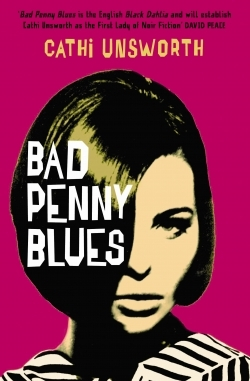Bad Penny Blues
One half of Cathi Unsworth’s latest novel, Bad Penny Blues, chronicles the ascent to success for young artists Stella and husband Toby. The other half of the story, alternating chapter by chapter with Stella’s voice, is the experience of Constable Pete Bradley. Bradley’s discovery of a murdered prostitute (the first of many to come) will color his career and draw him to the attention of powerful, often dangerous, people. As the years pass, Bradley becomes deeply enmeshed in investigating a world of police brutality, corruption, and violence.
Stella and Bradley’s stories mature with a third character: London during the tumultuous sixties. This incendiary time of social and political unrest, fraught with scandals, riots, and crime, makes for an increasingly treacherous setting. And although at first, Bradley and Stella’s stories are independent but for the presence of London in all its seedy glory, one major thread ties them together: Each time a prostitute is slain, Stella dreams she is that woman in her final moments. It is at such times that this period crime novel takes a turn for supernatural thriller.
As the plot develops, a number of Unsworth’s seemingly peripheral characters begin to appear in both storylines. Bradley and the artists are drawn into a web of similar people, of mystery, and of something very corrupt indeed. Bad Penny Blues traces the connection between London’s upper and lower crusts, and locates the wickedness in both. With candid language, Unworth spools out a story of sadistic men in power, their corrupt lives, and their violent desires for sex and power.
For the entire ride—and the novel is an entertaining yet serious experience—the reader is thrown off balance again and again. Lulled by the complexity of each character, the realistic depictions of each situation, and a very convincing catalogue of desires, fears, and emotions, readers are then jarred by the novel’s furious pace, explicit sexual allusions, and violence.
The result is a complicated yarn that simultaneously illuminates the spirit of a bygone era and casts it into shadow.
For those with an interest in London’s social and artistic scene during this period, Bad Penny Blues is an ideal read. Those without a developed familiarity with sixties English colloquialisms will find themselves reaching for a dictionary of slang: Unsworth’s novel is ripe with the idioms and expressions of the time, and readers will want to understand the nuances of every word.
Reviewed by
Leia Menlove
Disclosure: This article is not an endorsement, but a review. The publisher of this book provided free copies of the book to have their book reviewed by a professional reviewer. No fee was paid by the publisher for this review. Foreword Reviews only recommends books that we love. Foreword Magazine, Inc. is disclosing this in accordance with the Federal Trade Commission’s 16 CFR, Part 255.

